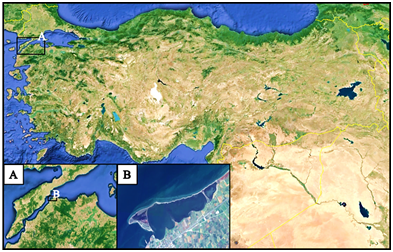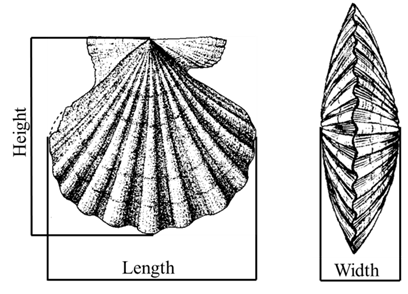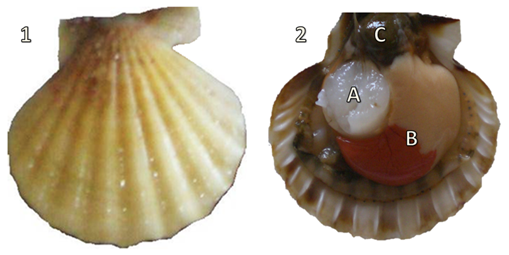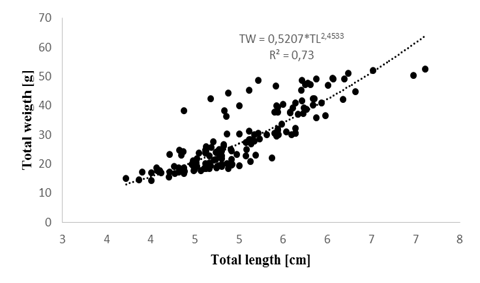Journal of
eISSN: 2378-3184


Research Article Volume 5 Issue 3
1Department of Fisheries and Processing Technology, Canakkale Onsekiz Mart University, Turkey
2Central Fisheries Research Institute, Turkey
3Institute of Marine Sciences and Management, Istanbul University, Turkey
Correspondence: Ekrem Cem
Received: November 30, 2016 | Published: March 21, 2017
Citation: Berika N, Çankiriligilb EC, Gülc G (2017) Meat Yield and Shell Dimension of Smooth Scallop ( Flexopecten glaber ) Caught from Çardak Lagoon in Canakkale, Turkey. J Aquac Mar Biol 5(3): 00122 DOI: 10.15406/jamb.2017.05.00122
In this research, meat yield and shell dimension of smooth scallop (Flexopecten glaber) were specified. 150 individuals of smooth scallop were caught by dredges seasonally in Cardak lagoon on Canakkale strait, Turkey. According to results, the relationship of total shell length between total shell weight was determined as TW = 0.5207* TL 2.4533 (R2= 0.73). Moreover, meat yield of scallop was determined highest as whole meat in spring and as adductor muscle in summer. This paper reveals basic growth data of smooth scallop and its preliminary study for Cardak lagoon which is important bivalve inhabiting area.
Keywords: Scallop, Flexopecten glaber, Shell dimension, Meat yield, Pecten
The share of scallops in European market among marine mollusk has increased significantly in recent years.1 In Mediterranean, smooth scallop (Flexopecten glaber) is one of the most high market valued species for the seafood sector with their high nutrient content as well as Pilgrim’ scallop (Pecten jacobaeus), black scallop (Mimachlamys varia) and queen scallop (Aequipecten opercularis).2 Besides, smooth scallop is convenient for aquaculture sector with having high growth rate and economical value.3,4 With these advantages, studies carried out in the northern Aegean Sea showed that overfishing caused a serious decrease in Flexopecten glaber stocks.2,3,5 According to Sarro & Stokesbury6 monthly variations of scallop meat yields must be detailed with the aim of adequate implementation of future fisheries management plans. Over the past years, although researches about biology of scallop has risen,7 it is not enough.
Cardak Lagoon is located on the Canakkale Strait in northern Aegean Sea and it is the most important area which has multiplexed freshwater entering, and hence creating optimum conditions for the production of bivalves.8 A few studies were carried out relevant to bivalve species inhabiting in Cardak lagoon,9, 10 However, not much work has been done related to smooth scallop .In this research, smooth scallops (Flexopecten glaber) were preferred due to their high economical potential. In our study, we evaluated meat yield and allometric relations of smooth scallop obtained from Cardak lagoon in order to compensate lack of knowledge still exists to basic data of this species. Thus, scientific studies on these valuable species should be enhanced to ensure sustainable use of scallops in the fishery along with seafood industry.
Sampling
Scallops were caught via dredges and samplings that were carried out seasonally between September 2011 and August 2012 in Canakkale Cardak lagoon (between 40°23ˈ00.11ˈˈK, 26°42ˈ52.05ˈˈD and 40°23ˈ44.46ˈˈK, 26°44ˈ25.00ˈˈD. All sampling done were carried out in the middle of each seasons. In this study, 150 individual scallops were used (autumn as 41, winter as 51, spring as 29 and summer as 29).
Specifying of Allometric Relations
Samples of smooth scallop specimens were obtained on a seasonal basis between August 2009-August 2010 using dredge in the Cardak Lagoon, Aegean Sea. The total length (SL) of the scallops (maximum distance along the anterior-posterior axis), width and height were measured with digital caliper to the nearest 0.01 mm and the weight was determined by using digital balance with an accuracy of 0.01g. Measurements of scallops were shown in Figure 2.

Figure 1 Sampling area of smooth scallop (Flexopecten glaber). A: Canakkale strait, Turkey; B: Çardak Lagoon as main sampling area (photos taken from Google earth, 2016).

Figure 2 Measurements of smooth scallop (Flexopecten glaber). The artworks were taken from (Fischer et al.11 and modified by the authors.
The relation of shell length (SL) to shell weight (SW), unshelled meat weight (MW) and adductor weight (AW) was calculated according to the allometric equation:
W= a* Lb using the least square regression analysis available in the Microsoft Excel.
Since weight is a power function of length, the logarithm is taken so that the exponential relationship can be expressed by a linear equation. This equation can be expressed in its linearized form: log W = log a + b log L
W is the shell weight (total weight, total unshelled meat, adductor muscle weight L is the shell dimension (Total length, width, height) whilst a is the intercept (initial growth coefficient) and b is the slope (relatives growth rates of variables).12 In the determination of allometric relations, t-test was applied to determine if the b value was significantly different from the isometric expected value of 3.13
Determination of Meat Yield
In the calculation of meat yield, two approaches were taken into consideration due to different scallop consuming preferences in the world. In the former, meat yield was calculated with whole edible combed out scallop meat including adductor muscle and all organs such as gonad, digestive gland, gill and others. In the latter, only the adductor muscle was taken as the meat yield measure which is the most common method of consumption of scallops over the world. According to Naidu14 ratio of adductor musce is being acceptable as meat yield. Besides that, scallop parts used in estimation of meat yield were shown on the anatomy of scallop in figure 3. The meat yield calculation was carried out throughout the year; thereby seasonal changes in the meat yields of scallops were identified. An equation was used to estimation of both meat yields as meat yield= [Meat weight (g)/ Total weight (g)] x 100.15 Differences between groups of meat yields were determined by one-way analysis of variance ANOVA using Tukey’s multiple comparison tests.16

Figure 3 Morphology of smooth scallop (Flexopecten glaber), 2: Anatomy of smooth scallop (Flexopecten glaber): Adductor (striped) muscle (A)*, gonad (B), digestive gland (C).
*In the calculation of meat yield ratios, adductor muscle (A) was estimated as singular and coupled with all other organs.
Allometric Relations and Shell Dimensions
In this study, 150 scallops were collected in range ranging from 3.72 to 7.11 cm in the total length and 14.11 to 52.36 g in the total weight (Table 1).
|
Measurements |
N |
Minimum |
Maximum |
Mean [SE] |
|
TSL |
150 |
3.72 |
7.11 |
5.03±0.634 |
|
TSW |
150 |
14.11 |
52.36 |
28.73±10.52 |
|
SW |
150 |
3.64 |
7.02 |
4.99±0,660 |
|
SH |
150 |
1.01 |
2.82 |
1.86±0.350 |
|
MW |
150 |
4.82 |
17.96 |
10.12+0.280 |
|
AW |
150 |
1.39 |
7.34 |
3.307+0.131 |
Table 1 Descriptive statistics of Flexopecten glaber from Canakkale Lagoon
*TSL, total shell length (cm); TSW, total shell weight (g); W, shell width (cm); SH, shell height (cm); MW, weight of unshelled whole edible scallop meat (g); AW, weight of adductor muscle.
*TSL, total shell length (cm); TSW, total shell weight (g); W, shell width (cm); SH, shell height (cm); MW, weight of unshelled whole edible scallop meat (g); AW, weight of adductor muscle.
According to length dimension frequency the most total length in 5 cm, width in 5 cm and height in 2 cm respectively. Pisor & Poppe17 represent the maximum total shell length of 8.66 cm. Allometric relations of smooth scallop were given in figure 4.

Figure 4 Total shell length total shell weight relationship of of Flexopecten glaber caught from Çardak lagoon in Canakkale/Turkey.
The height -weight relationship was calculated TW = 0.5207* TL 2.4533 (R2= 0.73). The total shell length frequency distributions were showed in Figure 5.
The height -weight relationship was calculated TW = 0.5207* TL 2.4533 (R2= 0.73). The total shell length frequency distributions were showed in Figure 5.
In this study, allometric relationships were determined between body size (total length, height and width) and weight in Cardak lagoon and total shell length-shell weight relationships were calculated and b value found less than three. This results show that this species exhibits negative allometric growth in this area; nevertheless b values can be affected the seasonal food availability.18 Unfortunately, there is no available data to concern these results in Aegean Sea, also in all Mediterranean basin. In spite of its economic value, there is a gap between its biology knowledge growth and reproduction periods. The results of shell dimension (total length, height and width) and weight (total shell weight, adductor weight and unshelled weight) relationships showed that strong relationship but total shell length between adductor weight and weight of unshelled shows little relationships for Flexopecten glaber in the Cardak lagoon(R2=0.43). These results explained adductor muscle and unshelled weight did not change much according to the total shell length growth. All allometric relationship between shell dimension and total weight are shown in Table 2.
|
Relationship |
a (±SE) |
b (±SE) |
r2 |
p |
|
SL on TW |
0.52 ± 0.08 |
2.45 ± 0.12 |
0.73 |
p>0.05 |
|
SL on W |
0.93 ± 0.01 |
1.03 ± 0.01 |
0.95 |
p>0.05 |
|
SL on SH |
0.20 ± 0.08 |
2.38 ± 0.12 |
0.72 |
P<0.05 |
|
SL on MW |
0.21 ± 0.04 |
1.34 ± 0.06 |
0.74 |
P<0.05 |
|
SL on AW |
0.06 ± 0.15 |
2.35 ± 0.21 |
0.43 |
p>0.05 |
|
TW on TW |
0.70 ± 0.08 |
2.28 ± 0.12 |
0.70 |
p>0.05 |
|
W on SH |
0.24 ± 0.04 |
1.26 ± 0.06 |
0.74 |
p<0.05 |
Table 2 Allometric relationship of Flexopecten glaber shell dimension (cm) and total weight, meat and adductor (g) from Çardak lagoon
*SL, shell length (cm); TW, total weight (g); W, width (cm); SH, shell height (cm); MW, weight of unshelled whole edible scallop meat (g); AW, weight of adductor muscle.
Ozvarol & Gokoglu19 studied relationship between sizes and dry weight measurements of another Pectinidae species Chlamnys varia in the Aegean Sea coast and according to b values Chlamnys varia shows negative allometric growth (b<3). There is no another studies to compare our results about pectinidae species shell dimension and allometric relationship.
Meat Yield
In scallops, meat yield depends on species, reproduction season, feeding regime and environment like most bivalves.20 Meat yield of scallop shows variation throughout the year due to reproduction pattern6 and the adductor muscle approximately comprises 10% of its total weight.14 In this research, the meat yield of smooth scallop was determined as 34.14%, 37.63%, 39.69%, 29.96% for whole meat and 14.74%, 10.02%, 8.61%, 15.02% as adductor muscle in autumn, winter, spring and summer respectively. The ratio of whole scallop meat increased in summer from 34.14% to 39.69. However in during summer season decreased to 29.96%. On the other hand, yields of adductor muscle showed decrease in autumn and spring (P<0.05). But in summer, ratio of adductor muscle increased to 15.02% contrary to whole meat. The reason for this discrepancy was the release of gonad which had grown during reproduction season of scallops,20 between late spring and summer. Especially in spring, the gonads exceed the ratio of adductor muscles and account for half of the scallop’s wet meat. According to Mol,21 maximum meat yield of scallop is just reached before the spawning. Also, several studies have shown that the total meat weight increases owing to the growth of gonads in the reproduction season.22,23 The seasonal changes on meat yields of smooth scallop were shown in figure 6.
Flexopecten glaber is the most important Pectinidae species and there is a gap of their biology and growth properties in our seas and Mediterranean. We do not have any information about state of population of smooth scallop and their reproduction properties in the Cardak lagoon so we use basic data to understand biology and growth parameters of species with limited data we have obtained. The results of this study only constitute parts of the basic population parameters. It is aimed that these results will contribute to further studies.
The authors would like to express gratitude to Deniz Can Bakkalci for improving English language.
None.

©2017 Berika, et al. This is an open access article distributed under the terms of the, which permits unrestricted use, distribution, and build upon your work non-commercially.